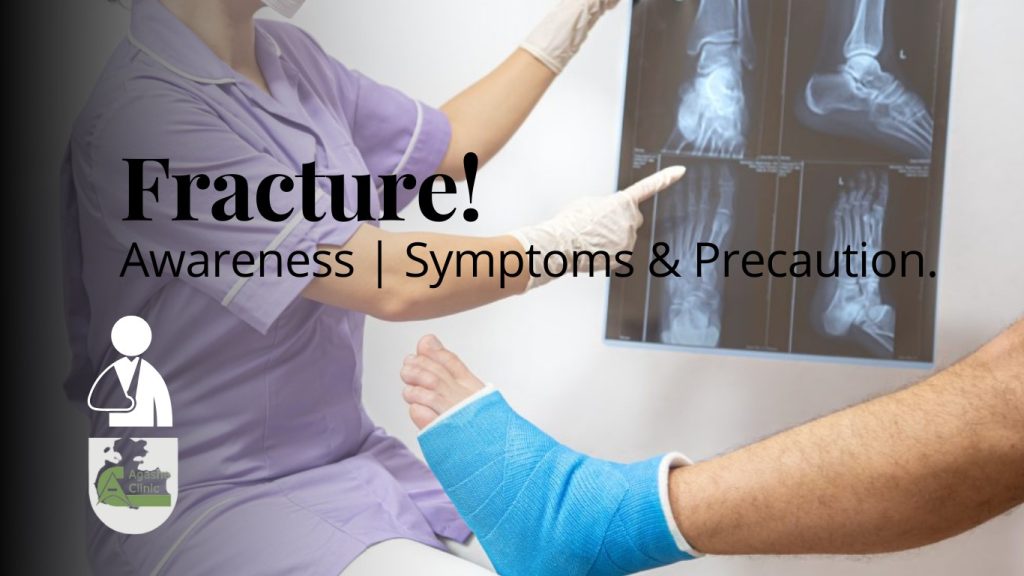A fracture is a break in the bone. An open or compound fracture occurs when a broken bone punctures the skin. Low bone density and osteoporosis are two other causes of bone weakness. When a bone is subjected to more force than it can withstand, it will split or break. A fracture is a break of any size.
A stress fracture is a break in the bone caused by repeated or prolonged forces on the bone. The repeated stress weakens the bone until it eventually fractures.
Fractures are commonly caused by:
- Car accidents
- Falls
- Sports injuries
Fracture Classification:
- Open (Compound) fracture
- Closed fracture
- Intra-articular fracture
Awareness:
It is difficult to distinguish between a dislocated joint and a broken bone. Both are emergencies, and the basic first aid procedures are the same.
Source:
The following are some of the most frequent cause of broken bones:
- Falling from a great height
- Trauma
- Motor vehicle accidents
- Direct blow
- Child abuse
- Repetitive forces, such as running, can result in stress fractures of the foot, ankle, tibia, or hip.
Symptoms:
- A visibly Dis-locate or misshapen limb or joint
- Swelling, bruising, or bleeding
- Intense pain
- Numbness and tingling
- Broken skin with bone protruding
- Limited movement or inability to move a limb or put weight on the leg
Care:
The following are some first aid procedures:
- Examine the individual’s airway and breathing. The local emergency number if necessary, and begin rescue breathing, CPR, or bleeding control.
- Maintain the person’s stillness and calm.
- Inspect the person carefully for other injuries.
- In most cases, if medical assistance arrives quickly, allow medical personnel to take further action.
- If the skin is broken, it should be treated as soon as possible to avoid infection.
Precautions:
- Call for emergency assistance right away.
- Do not breathe on or probe the wound.
- To avoid further contamination, try to cover the wound. If germ free dressings are available, cover with them.
- If you are not a medical professional, do not attempt to align the fracture.
- Take precautions to avoid being shocked.
- Place the person on their back, elevate their feet about 12 inches above their heads, and cover them with a coat or blanket.
- However, if a head, neck, or back injury is suspected, Must Not move the individual.
Steps to follow in Critical Condition:
# Check blood circulation
Examine the individual’s blood circulation. Firmly press on the skin beyond the fracture site. (For example, if the fracture is in the leg, apply pressure to the foot). It should blanch white for about 2 seconds before turning pink.
# Symptoms of poor circulation:
- Pale or blue skin
- Numbness or tingling.
- A loss of pulse.
Do readjust the limb into a normal resting position if circulation is poor and trained personnel are not readily available. This will reduce swelling, pain, and tissue damage caused by a lack of blood.
# Monitor and control Bleeding
- To dress the wound, place a dry, clean cloth over it.
- If the bleeding worsens, apply direct pressure to the wound.
- If the bleeding is not life threatening, do not apply a compression bandage to the extreme point.
- Once a bandage is applied, tissue can only survive for a limited time.
When to Contact a Medical Professional:
- There is a suspected broken bone in the head, neck, or back; or the person is not responding or is losing consciousness.
- A broken bone in the hip, pelvis, or upper leg is suspected.
- You cannot completely incapacitate the injury on the scene.
- There is crucial bleeding.
- A pale, cold, clammy, or blue area beneath the injured joint.
- A bone is protruding through the skin.
Even if other broken bones are not medical emergencies, they require medical attention. To find out where and when you can be seen, contact your Orthopedic.
If a little one refuses to put weight on an arm or leg after an accident, will not move the arm or leg, or there is a clear deformity, assume the child has a broken bone and seek medical attention.
Prevention:
Take the following precautions to reduce your chances of breaking a bone:
- When skiing, biking, roller blading, or participating in competitive sports, wear protective equipment. This includes wearing a helmet, elbow, knee, wrist, and shin pads.
- Keep a close eye on children. No matter how safe the environment or situation appears to be, there is no substitute for supervision.
Purchase the Proper Shoes:
When selecting shoes, consider more than just fashion. The wrong type of footwear can increase your chances of falling.
Maintain Proper Lighting in Your Home
You can help prevent falls by making sure your home has adequate lighting.
‘Fall-Proof’ Your Residence
Because you probably spend the majority of your time at home, making it safer is an important part of fracture prevention.
Treat Medical Conditions
Some long-term medical conditions can impair your strength and increase your chances of falling. For example, arthritis can make it difficult to move around, and vision problems can increase the likelihood of tripping.




